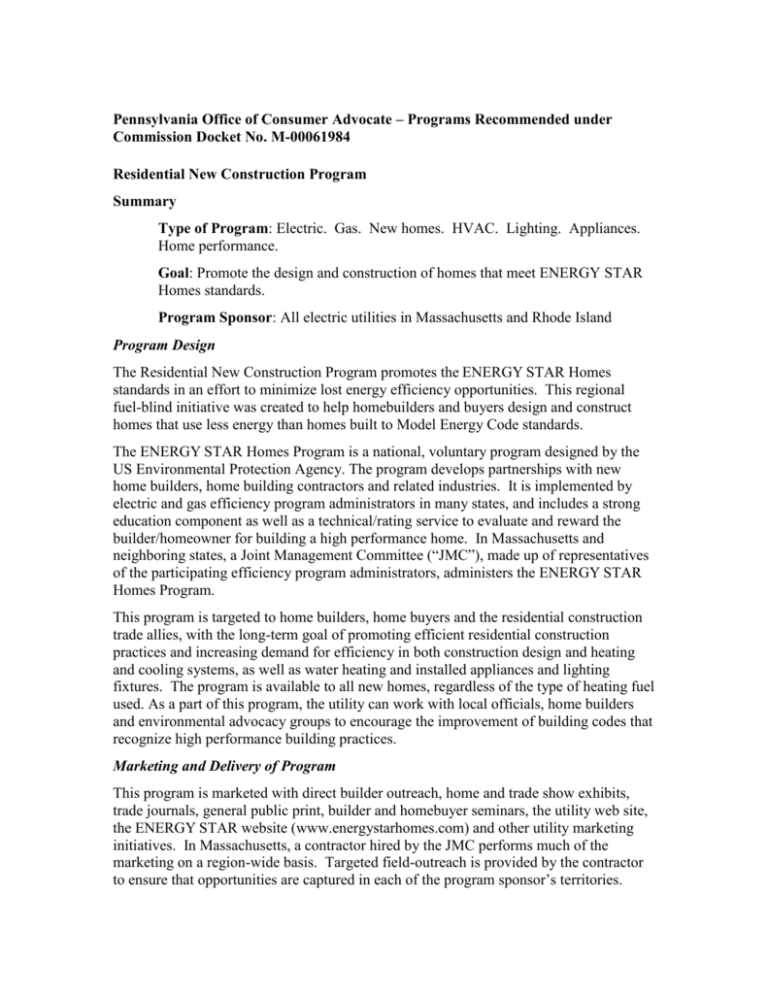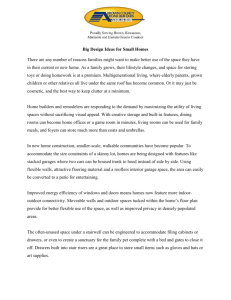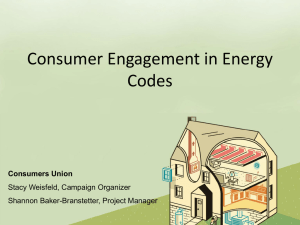Residential New Construction Program
advertisement

Pennsylvania Office of Consumer Advocate – Programs Recommended under Commission Docket No. M-00061984 Residential New Construction Program Summary Type of Program: Electric. Gas. New homes. HVAC. Lighting. Appliances. Home performance. Goal: Promote the design and construction of homes that meet ENERGY STAR Homes standards. Program Sponsor: All electric utilities in Massachusetts and Rhode Island Program Design The Residential New Construction Program promotes the ENERGY STAR Homes standards in an effort to minimize lost energy efficiency opportunities. This regional fuel-blind initiative was created to help homebuilders and buyers design and construct homes that use less energy than homes built to Model Energy Code standards. The ENERGY STAR Homes Program is a national, voluntary program designed by the US Environmental Protection Agency. The program develops partnerships with new home builders, home building contractors and related industries. It is implemented by electric and gas efficiency program administrators in many states, and includes a strong education component as well as a technical/rating service to evaluate and reward the builder/homeowner for building a high performance home. In Massachusetts and neighboring states, a Joint Management Committee (“JMC”), made up of representatives of the participating efficiency program administrators, administers the ENERGY STAR Homes Program. This program is targeted to home builders, home buyers and the residential construction trade allies, with the long-term goal of promoting efficient residential construction practices and increasing demand for efficiency in both construction design and heating and cooling systems, as well as water heating and installed appliances and lighting fixtures. The program is available to all new homes, regardless of the type of heating fuel used. As a part of this program, the utility can work with local officials, home builders and environmental advocacy groups to encourage the improvement of building codes that recognize high performance building practices. Marketing and Delivery of Program This program is marketed with direct builder outreach, home and trade show exhibits, trade journals, general public print, builder and homebuyer seminars, the utility web site, the ENERGY STAR website (www.energystarhomes.com) and other utility marketing initiatives. In Massachusetts, a contractor hired by the JMC performs much of the marketing on a region-wide basis. Targeted field-outreach is provided by the contractor to ensure that opportunities are captured in each of the program sponsor’s territories. This program is also delivered in the field by builder-interface technicians employed by the contractor who is, in turn, hired by the JMC (“Delivery Contractor”). The Delivery Contractor works with home builders and buyers, applies the Home Energy Rating System (“HERS”) to the home, and provides the HERS certification. The Delivery Contractor processes the rebates and financial incentives offered directly through the program and leverages other energy efficiency rebates and offers that may be available from time-to-time. Addressing Households Using Electricity and Natural Gas The OCA urges the Commission to consider explicit integration of electric and gas measures. In may parts of the Commonwealth, consumers are customers of both gas and electric utilities. Many, significant savings opportunities will be missed if either the gas utility or the electric utility provide demand response, efficiency and education without treating the needs related to the other utility’s service. The OCA provides an abbreviated presentation of some gas-related proposals where these are essentially duplicated by our proposals related to electric programs. Efficiency Measures and Customer Incentives This program promotes efficiency upgrades to all end-uses in a new home, including building shell, HVAC, domestic water heating, and ENERGY STAR lighting and appliances. Beginning in 2007, the ENERGY STAR Homes criteria are more stringent than in the past. This will make it more challenging for builders to reach the standard. Accordingly, three options are now offered to builders to participate in the program: The program offers an ENERGY STAR plan review, a pre-construction meeting, a post installation inspection, and HERS certification for homes that meet the ENERGY STAR standards. Incentives will be provided to home builders that equal or mostly offset the incremental cost of achieving the HERS certification. The program offers a Builders Option Package (BOP), which includes a predetermined set of efficiency measures which are expected to achieve the efficiency level of the ENERGY STAR Homes, without using the HERS certification process. This significantly reduces the administration and transaction costs of the builders and is expected to enhance program participation. The program offers a Codes Plus option, where homes builders and homeowners can receive incentives for achieving efficiency savings that exceed the local building code, but might not be sufficient to reach the ENERGY STAR Homes standard. The purpose of this option is to assist those builders who want to improve the efficiency of homes but are unable or unwilling to take all the actions necessary to achieve the ENERGY STAR Homes standard. Prescriptive incentives will be offered for three categories of measures: appliances, thermal measures, and heating, ventilation and air conditioning measures. Recent Program Performance This program has been in operation since 1998. The performance results for the calendar year 2005 are summarized below. Massachusetts Electric NSTAR Electric Western Mass. Electric 1,696,437 1,804,909 511,192 Benefit-Cost Ratio 1.8 1.2 1.4 Net Benefits (million present value $) 1.7 0.3 0.3 Cost of Saved Electricity ($/lifetime MWh) 140 194 171 Program Budget ($/year) Note that this program achieves gas efficiency savings as well as electric, and thus the cost of saved electricity (in $/lifetime MWh) does not capture all the energy benefits. Also note that, while this program does not offer as many quantifiable benefits as some other programs, it should be given relatively high priority because it helps to prevent lost opportunities. Related Expertise in Pennsylvania The Pennsylvania Housing Finance Agency (PHFA) has emphasized ENERGY STAR compliance through its RPS for new construction. At present, PHFA is conducting a trail under which all new construction must meet the ENERGY STAR Homes standard. This is enforced through a mandatory inspection by a HERS-certified inspector. For other new construction, PHFA has also emphasized but not mandated compliance with ENERGY STAR Homes. Thus, there is Pennsylvania-specific, substantial expertise related to implementing ENERGY STAR standards. The OCA encourages the Commission to work with PHFA in reviewing the potential program proposed under this submission.









